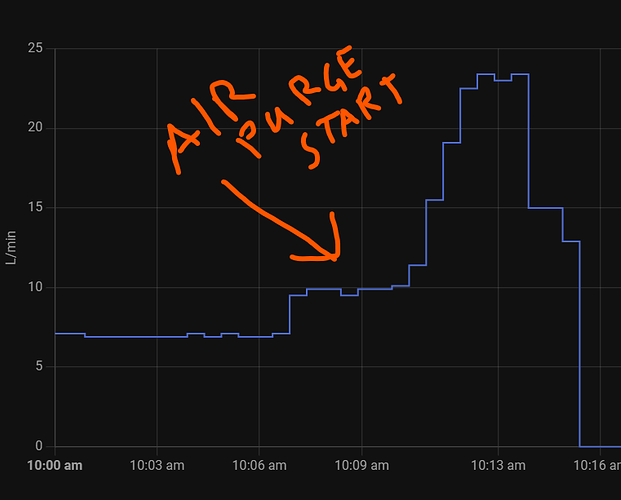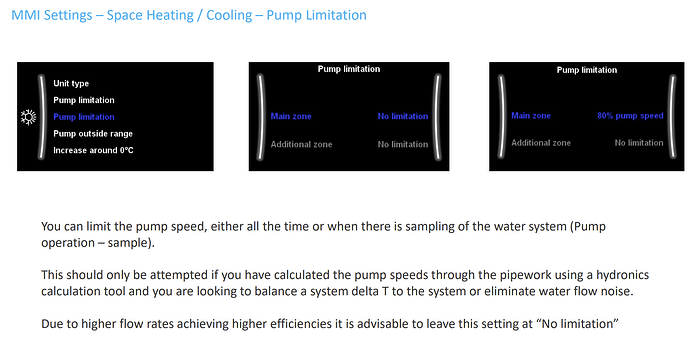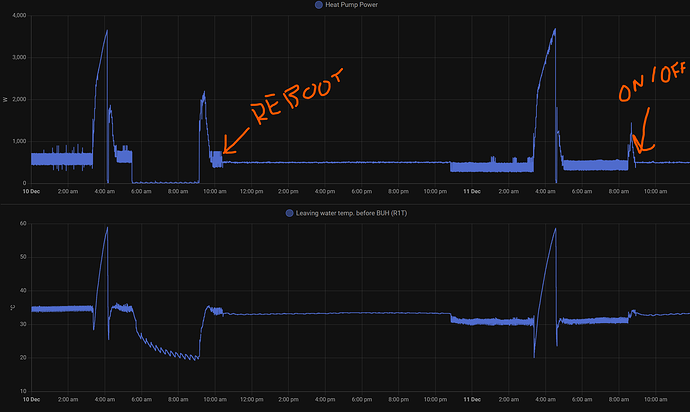agreed, too many leavers, that’s why i have gone with a Home Assistant external control hybrid model that is a LWT/WDC & on/off but with my hysteresis and ground floor temperature rather than one room controlling the lower and upper temperatures on/off, not really a user-friendly option.
Hi @matt-drummer, please do not take this the wrong way, just trying to help, and share my results regarding the LWT and getting to a set or ‘programmed’ value
Taking the following into account -
WDC was set - at the current outside of 6 the LWT should be roughly 35, but the MMI displayed 31 and my records confirmed this, the LWT was indeed in steady state and did not change from 31, and the L/min has been on the floor at 7 L/min throughout (no modulation/Madoka control, just pure weather compensation).
Over the last week, I have been trying to balance the radiators to DT 5, sidenote - mainly to reduce the upstairs temps without using external influences such as digital TRV’s set to a temp resulting in shutting down the radiator, not good.
So….
I wondered if the flow was limited too much, the lockshields were a bit noisy, I ran an air purge and confirmed the MMI (and ESPAltherma) only displayed 10 L/min on a max/high space air purge, something is wrong here! So, I opened the downstairs radiators (sized correctly), and I could see the L/min increase, to the max of 24 L/min, obvious right?
Like all trial-and-error methodology, make one change and see the result.
The immediate result is now on the MMI screen I can see the LWT at 35 not 31, can your system get up-to 24 L/min on an air purge test (I think you also have limited the pump to 60%)? If not, could this be limiting the unit not changing the LWT, on your manual input, just like my experience?
I will also report back when the heating switches back on with the results, the house is up to temp now.
Just thinking out loud do you have a volumiser with a bypass ?? I did consider doing some experiments with this maybe shutting of the by pass completely or opening it up
It’s shut off ![]()
I did wonder if the pressure was building up then the bypass releasing
Does it shut off completely ??
I think so, I am sure others will chime in if i am wrong.
another thought , octopus left my heating circuit at 1.5 bar and i have been making sure it stays around 1.5 bar , i have just been looking through the daikin stuff and 1.5 bar is the minimum pressure so i am going to increase mine to 1.8 bar and see if it makes any difference
My installer did say he like to leave it closer to but not more than 2 but didn’t say why and I didn’t question it at the time.
@matt-drummer with the significant radiator changes made to the system did you also look at the pipework calcs?
Hi Ben,
No, I just fitted much larger radiators.
Why do you ask?
36 posts were split to a new topic: Heating power calculation from ESPAltherma data
Hi @meatballs, is this what you are thinking?
Monday update, yes, opening the radiators 100% downstairs (sized correctly to the heat loss) helped me get a higher more accurate LWT, hope this helps others?
Hi Neil,
My flow rate is only affected at the start of a space heating cycle in reality.
All my 60% limitation does is stop the amount of heat produced in the first 20 minutes or so and this is only of use when running low flow temperatures at higher outdoor temperatures.
Otherwise I don’t need the limitation, and I probably don’t need it at any time now as I have worked out that really low flow temperatures are a no go.
So, even if I removed the pump speed limitation I would still be running on radiators at a dT of 10c with the flow rate firmly fixed on the bottom.
Unfortunately, although Daikin say that higher flow rates result in higher efficiency, their heat pump cannot run at a consistent higher flow rate, instead it constantly changes from one extreme to another trying to get control of the return temperature.
I have found this to be less efficient.
With regard to pipe work and radiator sizes, changing the radiators has not changed the heat loss or the amount of heat I want the heat pump to deliver, I am just able to do it at a lower flow temperature with bigger radiators.
I am pretty sure that even the worst pipe work can deliver a maximum of 4kW at 7lpm.
Hi @alibloke, I was told the firmware was supposed to improve the responsiveness of the expansion valve. That’s all I know and I can’t say I noticed any before/after changes from my monitoring of it using ESPAltherma.
I think the big improvement for my system was getting the tape heaters disabled. Before, my system would not deliver a reliable delta-T to my house as it was tape heating the water returning to the heat pump! ![]()
Hi @Chris_Hill you may be onto something, I made a change yesterday morning that caused a reboot – nice steady LWT and constant 500w draw, ~12hrs later back to fluctuating power and LWT, this morning I initiated a short on/off via onecta and its back to a nice steady LWT and constant 500w draw. This could be good evidence for a Daikin support ticket?
the only down side to doing this , is the hot water cycle starts after the restart if your water in tank is cool enough , did you just switch on/off the Central Heating in the app ( does this start the hot water cycle ??
Yes, I just turned off the space/central heating via the API in HA (same as in the app), no DHW heat, just the mini peak before settling down.
makes you wonder if the long runs are over whelming the refrigerant over the long runs
or the inverter is running at such a low frequency (Hz) compressor is struggling and if this is the case the compressor is going to have a very life span, ideally the frequency should be running the compressor between 40-70Hz once you start running outside of this the inverter and compressor will have reduced life
12 posts were split to a new topic: ESPAltherma / ESP32 power supply problems


